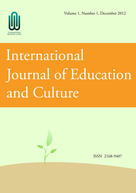


Volume 13 Issues 3-4 (2024-12-31)
Volume 13 Issues 1-2 (2024-06-30)
Volume 12 Issues 3-4 (2023-12-31)
Volume 12 Issues 1-2 (2023-06-30)
Volume 10 Issues 1&2 (2021-06-30)
Volume 9 Issues 3&4 (2020-12-31)
Volume 9 Issues 1&2 (2020-06-30)
Volume 8 Issues 3&4 (2019-12-31)
Volume 8 Issues 1&2 (2019-06-30)
Volume 7 Issues 3&4 (2018-12-31)
Volume 7 Issues 1&2 (2018-06-30)
Volume 6 Issues 3&4 (2017-12-31)
Volume 6 Issues 1&2 (2017-06-30)
Volume 5 Issues 3&4 (2016-12-31)
Volume 5 Issues 1&2 (2016-06-30)
Volume 4 Issues 3&4 (2015-12-31)
This study offers a comparative analysis of the flawed female characters in the works of Xianzu Tang and William Shakespeare, employing a cross-cultural lens to explore the complexities of female experiences within patriarchal frameworks. By examining characters such as Huo Xiaoyu and Portia, the study critically interrogates how societal norms and playwrights' perspectives contribute to the objectification and subversion of female identities. The analysis highlights how these portrayals reflect the limitations imposed by patriarchal ideologies and reveal the cultural and historical forces shaping gendered narratives. Ultimately, the paper demonstrates the enduring influence of traditional gender views in shaping the representation of women in classical literature.
This article explores the evolving role of financial aid in supporting the comprehensive development of students in higher education, particularly those from economically disadvantaged backgrounds. Recognizing the increasing importance of not only economic support but also spiritual motivation, career development, and social adaptability, the study emphasizes the need for targeted financial assistance that aligns with students' specific needs, academic progression, and professional aspirations. By drawing on current practices and theories, the article proposes a multifaceted approach to financial aid, highlighting the importance of personalized aid strategies, career empowerment, and the cultivation of social responsibility. Key recommendations include the establishment of scientific identification mechanisms for financial aid recipients, the development of comprehensive quality training platforms, and the creation of supportive networks for students' social and spiritual growth. This paper advocates for a more integrated financial aid system that not only addresses financial challenges but also contributes to students' holistic development, ensuring their successful transition from higher education to the workforce and fostering a more equitable and sustainable educational landscape.
This article explores the implementation and effectiveness of internationalized teaching practices at Jiangsu University, aimed at cultivating interdisciplinary, multi-level, and innovative engineering talents. By focusing on emerging engineering disciplines, the university has developed a comprehensive international teaching system that integrates cross-national and interdisciplinary teams to foster engineering innovation. The system combines traditional classroom teaching with modern multimedia learning, emphasizing experiential learning through collaboration, brainstorming, and innovative projects. Key initiatives, such as the Summer Program of Innovative Engineering Design (SPIED) and various international engineering competitions, are outlined to demonstrate how these practices enhance students' international perspectives, creativity, and technical capabilities. Additionally, the article examines the effectiveness of this model in breaking through traditional boundaries, promoting interdisciplinary integration, and improving engineering practice abilities. The findings suggest that such internationalized teaching approaches not only enhance technical and leadership skills but also prepare students for the global demands of emerging engineering fields.
This article evaluates the role of Artificial Intelligence (AI) in enhancing classroom assessment in English-as-foreign-language (EFL) writing. With the increasing integration of AI technologies in education, AI tools such as automated essay scoring systems, grammar checkers, and plagiarism detectors are gaining attention for their potential to improve assessment efficiency and provide instant feedback to students. This paper reviews current literature on AI's applications in EFL writing assessment and discusses both the benefits and limitations of using AI in this context. It also examines the effectiveness of AI tools through case studies and explores the challenges faced by educators and students. The article concludes by offering insights into the future of AI in language education and providing recommendations for further research and practical implementation.